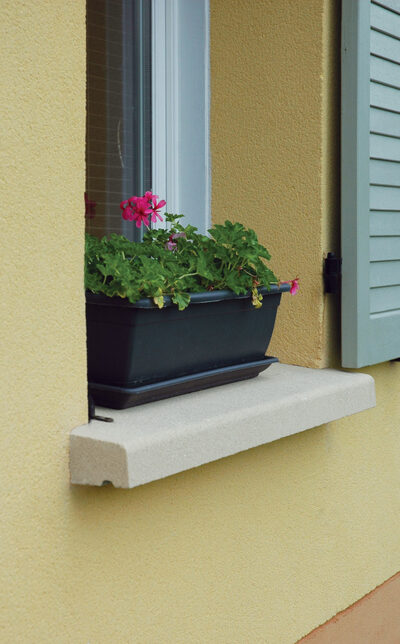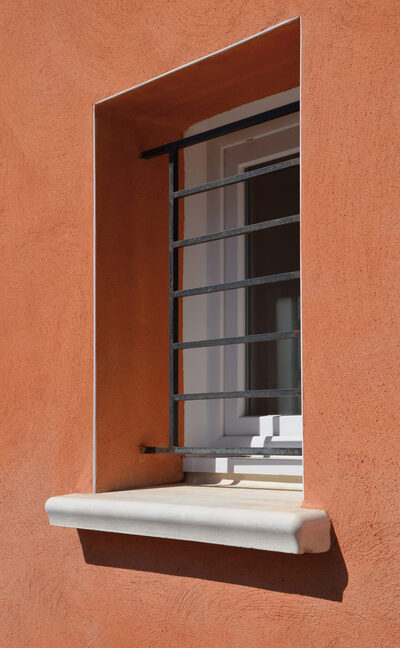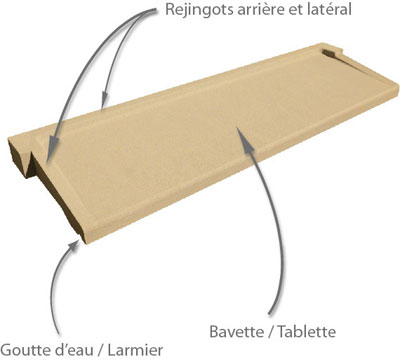How to choose your windowsills and doorsills?

The choice of window sills and door sills underlines the aesthetics of the house.
Indispensable for single-family homes and apartment buildings, in new-build or renovation projects, sills and thresholds support window and door units. Their role is to evacuate rainwater to the outside. They prevent infiltration under the frames, making the home watertight, and protect the facade. These products are indispensable for the home.
On site or prefabricated?
These products are either manufactured directly on site or prefabricated.
On-site window and door trims are generally made of concrete, poured by the mason before or after the joinery has been installed, depending on the method used. Made using special formwork, they have the advantage of being made-to-measure, and are ideal for non-standard openings. On the other hand, their design is tedious and time-consuming, and does not always guarantee a perfect seal.
We therefore recommend the use of prefabricated, standardized elements, as this saves installation time and guarantees the best quality/price ratio.
Some prefabricated products can be ordered made-to-measure.
Which materials to choose?
You can find different materials for windowsills and doorsills. The most popular materials are concrete, reconstituted stone and aluminum.
Prefabricated sills and thresholds in reconstituted stone:
Their technical features make these products an excellent choice:
- Optimum insulation (supports with reinforced thermal insulation),
- Shapes and profiles adapted to the construction zone (e.g. supports adapted to earthquake zones),
- Competitively priced and available from materials dealers and selected DIY superstores,
- A host of original, aesthetic finishes to enhance the facade: perfectly smooth texture for easy maintenance, rounded ears for a traditional style or very straight shapes for a contemporary look,
- Durability over time thanks to frost and weather resistance.
- Some references are certified to NF P 98-052, a guarantee of product quality and performance.


Reconstituted stone edges, stronger than aluminum:
Their modern aesthetic, wide range of colors and numerous possible finishes make reconstituted stone products an original solution for home decoration. Little maintenance is required. On the other hand, even if a simple wipe down with a sponge from time to time is all that’s needed on aluminum, this material quickly proves noisy in use, especially when rain and hail fall on it. We recommend placing insulation under the shelf to avoid this phenomenon. What’s more, their thermal insulation is poor. Reconstituted stone makes up for these inconveniences.
The profile of window sills and door sills :
You can choose from a range of support and door shelf shapes.
– Aluminum products are slim and lightweight, with a modern design and color scheme.
– Sills and thresholds in concrete or reconstituted stone easily reproduce natural stone, allowing you to maintain a traditional or contemporary look.
The window sill is made up of specific parts:
- The bib, also known as the shelf, is the most visible part of the product. This is where flowerpots or decorative elements can be placed. Its 10% slope is imperative to comply with DTU 20.1 standards.
- Rear and side splashbacks: not all sills and thresholds have them, but they are essential for draining rainwater, directing it towards the front of the sill.
- Lugs: not present on all models, they allow the product to be recessed into the opening without having to break the masonry (e.g. WESER simplified threshold).
- The water drip or drip edge : this part, located under the entire length of the sill and threshold, discharges rainwater away from the facade wall, protecting it from possible soiling.
The installation of window sills and door sills depends on the model chosen, but must always refer to DTU 20.1.
All these regulatory documents are available from AFNOR or CSTB: www.boutique.afnor.fr and www.boutique.cstb.fr

Designation of window sills and door sills:
There are different types of designation for these products.
Window sills can also be called :
- assises,
- edges or borders,
- bassoires,
- rims,
- window sills,
- window sills,
- or window stones,
- or window sills.
For door thresholds and bay windows, the terms :
- ramp,
- door nosing,
- door sill,
- door sill,
- plate,
- bearing,
- or door sill.
All its different nominations indicate the product present under the window, French window, door or bay window.
